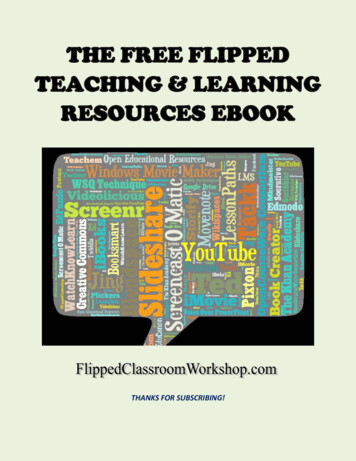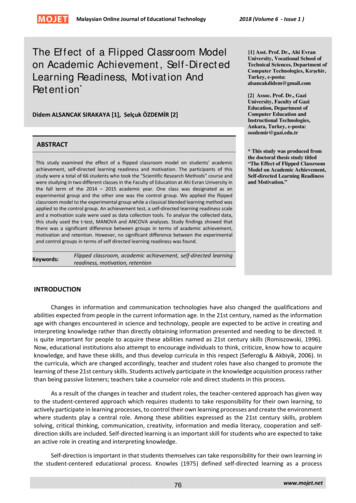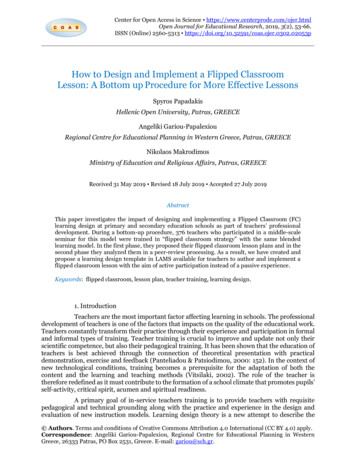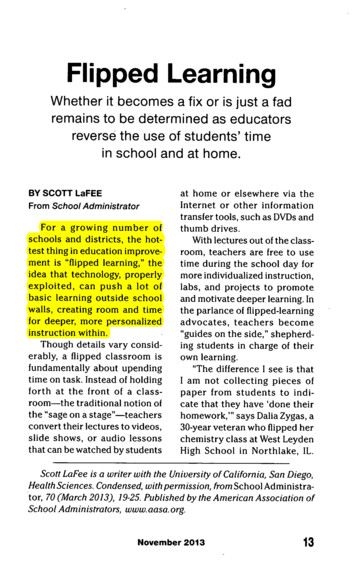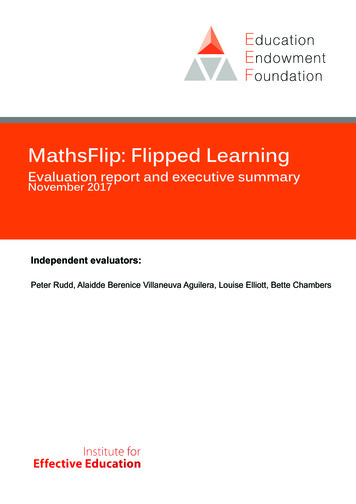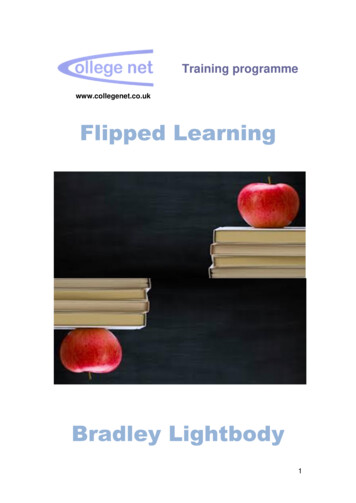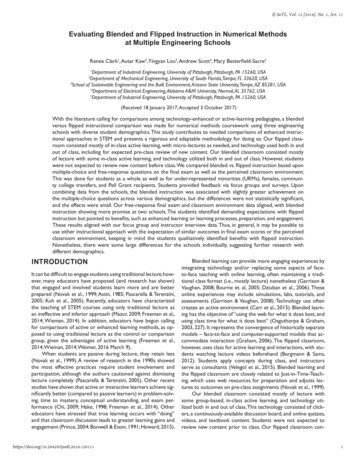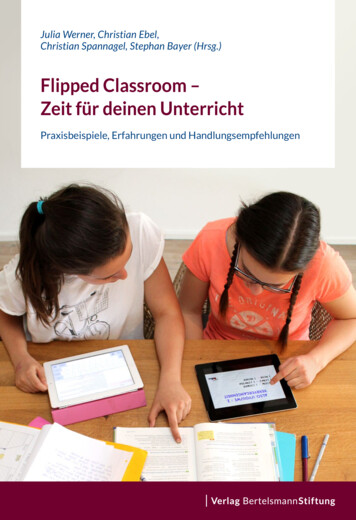
Transcription
A REVIEW OFFLIPPED LEARNINGWRIT TEN BYNoora Hamdan and Patrick McKnight, Ph.D. George Mason UniversityKatherine McKnight, Ph.D. Pearson’s Center for Educator EffectivenessKari M. Arfstrom, Ph.D. Flipped Learning NetworkPEER REVIEW SUP PORT FROMthe FLN’s Research Committee(c) Flipped Learning Network 2013
ACKNOWLEDGEMENTSThank you to the following educators whoreviewed various versions of this literature review,white paper and executive summary. Their inputwas invaluable to the creation and editing ofthese documents.Special thank you to the following for theireditorial assistance and careful review:Lori Brown, Ed.D., Pearson School AchievementServices (Asheville , NC)Chris Luker, Chemistry Teacher, Highland LocalSchools (Medina, OH); Doctoral Student,Kent State University (Kent, OH)Helaine W. Marshall, Associate Professor ofEducation and Director of Language EducationPrograms, Long Island University-Hudson(Purchase, NY)Lindsay C. Masland, Assistant Professor ofPsychology, Appalachian State University(Boone, NC)Richard Lee Colvin (Washington, D.C.)Barbara Hockstader, Pearson (New York, NY)THE FLIPPED LEARNING NETWORK’SRESEARCH COMMITTEEJonathan Bergmann, Board Member, FlippedLearning Network (Arlington, VA). LeadTechnology Facilitator, The Joseph Sears School(Kenilworth, IL)Kristin Daniels, Board Member, Flipped LearningNetwork (Arlington, VA). Technology andInnovation Coach, Stillwater Area Public Schools(Stillwater, MN)Anna Davis, Associate Professor of Mathematicsand Department Head, Ohio DominicanUniversity (Columbus, OH)Thomas F. Driscoll III, Social Studies Teacher,Putnam High School (Putnam, CT)Troy F. Faulkner, Mathematics Teacher, Byron HighSchool (Byron, MN); Adjunct Professor, AugsburgCollege (Rochester, MN)Jerry Overmyer, Mathematics and ScienceOutreach Coordinator, Mathematics Instructor,MAST Institute, University of Northern Colorado(Greeley, CO)Aaron Sams, Board Member, Flipped LearningNetwork (Arlington, VA); Director of DigitalLearning, Reformed Presbyterian TheologicalSeminary (Pittsburgh, PA)AUTHORSNoora Hamdan, Master’s Student,George Mason UniversityPatrick E. McKnight, Associate Professor ofPsychology, George Mason UniversityKatherine McKnight, Principal Directorof Research, Center for Educator Effectiveness,PearsonKari M. Arfstrom, Executive Director,Flipped Learning NetworkDavid J. Harrison, Instructional Designer,University of Nevada, Reno; Adjunct AssistantProfessor of Educational Technology, WebsterUniversity (St. Louis, MO); Doctoral student, OldDominion University (Norfolk, VA)A REVIEW OF FLIPPED LEARNING2
INTRODUCTIONA teacher stands at the front of the classroom, delivering a lecture on the Civil War and writing on a whiteboard. Students are hunched over desks arranged in rows, quietly taking notes. At the end of the hour, theycopy down the night’s homework assignment, which consists of reading pages from a thick textbook andanswering the questions at the end of the chapter. This dramatic, defining period in our nation’s history,which left questions unanswered that are as relevant today as they were then, has been reduced to a dry,if familiar, exercise. The teacher is acutely aware that many students do not understand the day’s lessonbut does not have the time to meet with them individually during the 50-minute class period. The next daythe teacher will collect and briefly review the homework assignment. If students have additional questionsthere won’t be much time to linger. The class cannot fall behind schedule. There is a lot of material to coverbefore the test at the end of the unit.Educators have been working to break this lecture-centered instructional model by shifting the focus fromthe curriculum pacing guide to student learning needs as the driver of instruction. They are, increasingly,turning to an alternative model of instruction called Flipped Learning in which digital technologies are used toshift direct instruction outside of the group learning space to the individual learning space, usually via videos.Offloading direct instruction in this way allows teachers to reconsider how to maximize individual face-toface time with students. Time becomes available for students to collaborate with peers on projects, engagemore deeply with content, practice skills, and receive feedback on their progress. Teachers can devotemore time to coaching their students, helping them develop procedural fluency if needed, and inspiring andassisting them with challenging projects that give them greater control over their own learning.Regarded as the pioneers of Flipped Learning, in 2007, two rural Colorado chemistry teachers, who wereconcerned that students frequently missed end-of-day classes to travel to other schools for competitions,games or other events, began to use live video recordings and screencasting software to record lectures,demonstrations, and slide presentations with annotations. Those materials were posted on the then-nascentYouTube for students to download and access whenever and wherever it was convenient. But the mode ofdelivery turned out to be less important than what it made possible. In a book on their work called Flip YourClassroom: Reach Every Student in Every Class Every Day (2012), the two teachers, Jonathan Bergmannand Aaron Sams, reported that, after they flipped their classroom, students began interacting more in class.Moreover, because time could be used more flexibly, students who were behind received more individualattention while advanced students continued to progress.In early 2012, Sams and Bergmann started the not-for-profit Flipped Learning Network (FLN) to provideeducators with the knowledge, skills, and resources to successfully implement the Flipped Learning model.The goals of the organization are to provide professional learning opportunities on Flipped Learning; toconduct, collaborate and disseminate relevant research on Flipped Learning; and to act as the clearinghousefor distributing best/promising practices for current and future “flipped” educators. Preceding the FLN wasan online Community of Practice called the Flipped Learning Ning, which is a free website for educatorswho have flipped or wish to flip their classes. It is hosted by the Math and Science Teaching Institute at theUniversity of Northern Colorado and maintained by Jerry Overmyer. One gauge to measure the interest inFlipped Learning is indicated by the number of participants in the Ning; in January 2012, there were 2,500members; by March 2013, more than 12,000 educators had signed up. 11 M ore information about the Flipped Learning Network can be found at www.flippedlearning.org. To join the Ning, a free onlinecommunity of practice, go to www.flippedclassroom.org.A REVIEW OF FLIPPED LEARNING3
As technologies and broadband become more widely available and as the focus on integrating technologyinto learning increases, interest in Flipped Learning will likely continue to grow. In recognition of this interest,the Flipped Learning Network, with the support of Pearson Education and researchers at George MasonUniversity, undertook a comprehensive review of relevant research. In this review, we define and describethe Flipped Learning model, briefly note its historical foundations and address common misconceptions.We discuss learning theories that underlie the model and describe current, although limited empiricalresearch findings. We also describe concerns that have been raised.DEFINING FLIPPED LEARNINGIn the Flipped Learning model, teachers shift direct learning out of the large group learning space and moveit into the individual learning space, with the help of one of several technologies. Teachers record andnarrate screencasts of work they do on their computer desktops, create videos of themselves teaching,or curate video lessons from internet sites such as TED-Ed and Khan Academy.2 Many educators startflipping their classroom by using these readily available materials. The videos or screencasts are available forstudents to access whenever and wherever it is convenient—at home, during study hall, on the bus, even inthe hospital—as many times as they like, enabling them to come to class better prepared (Musallam, 2011).Capitalizing on the students’ preparation, teachers can devote more time to opportunities for integratingand applying their knowledge, via a variety of student-centered, active learning strategies such as conductingresearch or working on projects with classmates. Teachers also can use class time to check on each student’sunderstanding and, if necessary, help them develop procedural fluency. Teachers can provide individualizedsupport as students work through the activities designed to help them master the material, meeting them attheir readiness level.Flipped Learning has been compared to online, blended, and distance learning because of the screencast orvideo components, but, there are clear differences. Online education, for example, occurs only remotely,and the teacher and student are never face-to-face (Oblinger & Oblinger, 2005). Virtual class meetings,assignments, and lectures happen online through a course management website usually, but not always,asynchronously. Sometimes the lectures and other activities are augmented by group chats or other meansof facilitating collaboration and peer instruction. Blended classes also have an online element, but thatusually occurs during class time along with direct student-teacher contact (Allen, Seaman, & Garrett, 2007).Students’ experiences in face-to-face sessions vary, however, and are not necessarily different than whatoccurs in a traditional classroom.That is also the case in some flipped classrooms. The use of videos or other digital technologies to delivercontent outside of class does not guarantee that anything different will occur during class time. However,due to the emphasis on students becoming the agents of their own learning rather than the object ofinstruction, the Flipped Learning model can enable educators to make the shift from teacher-driveninstruction to student-centered learning.2 T ED-Ed (ed.ted.com) has an entire library of educational videos, made specifically accessible to professional educators who haveflipped their classrooms. Likewise, Khan Academy has over 4,000 videos (khanacademy.org), many focusing on math and science,from which to select. Salman Khan, the website’s founder, has said that while the Academy “has been associated with the idea of the‘flipped classroom’ the concept was actually conceived by others before Khan Academy existed” (Khan, 2012).A REVIEW OF FLIPPED LEARNING4
STUDENT ENGAGEMENTFOUR PILLARS OFFLIPPED LEARNINGJust as no two traditional classrooms are identical,such is the case with flipped classrooms. BecauseFlipped Learning focuses on meeting individualstudent learning needs as opposed to a setmethodology with a clear set of rules, a cadreof experienced educators from the FlippedLearning Network, along with Pearson’s SchoolP ILLARS OF F LIPPED L EARNINGAchievement Services (2013), identified the keyfeatures, or pillars, of flipped classrooms that allow Flipped Learning to occur. The four Pillars of F-L-I-PTMare Flexible Environment, Learning Culture, Intentional Content, and Professional Educator.F L I P P ED L EARNING RE Q U IRE S F LE X IBLEEN V I RO N M ENTSFlipped classrooms allow for a variety of learning modes; educators often physicallyrearrange their learning space to accommodate the lesson or unit, which might involvegroup work, independent study, research, performance, and evaluation. They create FlexibleEnvironments in which students choose when and where they learn. Flipped educators acceptthat the in-class time will be somewhat chaotic and noisy, as compared with the quiet typicalof a well-behaved class during a lecture. Furthermore, educators who flip their classes are flexible in theirexpectations of student timelines for learning and how students are assessed. Educators build appropriateassessments systems that objectively measure understanding in a way that is meaningful for students and theteacher.F LI P P ED LEA RNING RE Q U IRE S A S HIF T INLEA R N I N G CU LTU REIn the traditional teacher-centered model, the teacher is the main source of information,the teacher is the “sage on the stage” (King, 1993), i.e. the sole content expert whoprovides information to students, generally via direct instruction lecture. In the FlippedLearning model, there is a deliberate shift from a teacher-centered classroom to a studentcentered approach, where in-class time is meant for exploring topics in greater depth and creating richerlearning opportunities. Students move from being the product of teaching to the center of learning, wherethey are actively involved in knowledge formation through opportunities to participate in and evaluate theirlearning in a manner that is personally meaningful. Students can theoretically pace their learning by reviewingcontent outside the group learning space, and teachers can maximize the use of face-to-face classroominteractions to check for and ensure student understanding and synthesis of the material. Flipped educatorshelp students explore topics in greater depth using student-centered pedagogies aimed at their readinesslevel or zone of proximal development, where they are challenged but not so much so that they aredemoralized (Vygotsky, 1978).A REVIEW OF FLIPPED LEARNING5
F LI P P ED LEARNING RE Q U IRE SI N T EN T I O NAL C O NTE NTFlipped educators evaluate what content they need to teach directly, since lectures arean effective tool for teaching particular skills and concepts, and what materials studentsshould be allowed to explore first on their own outside of the group learning space. Theycontinually think about how they can use the Flipped Learning model to help students gainconceptual understanding, as well as procedural fluency. Educators use Intentional Content to maximizeclassroom time in order to adopt various methods of instruction such as active learning strategies, peerinstruction, problem-based learning, or mastery or Socratic methods, depending on grade level and subjectmatter. If they continue to teach using a teacher-centered approach, nothing will be gained.3F LI P P ED LEARNING RE Q U IRE SP RO F ES S I O NAL E DU C ATO RSSome critics of Flipped Learning have suggested that the instructional videos employed in themodel will eventually replace educators. That is misguided. In the Flipped Learning model,skilled, Professional Educators are more important than ever, and often more demanding,than in a traditional one. They must determine when and how to shift direct instruction fromthe group to the individual learning space, and how to maximize the face-to-face time between teachersand students. Gojak (2012) noted that the right question for educators to ask themselves is not whetherto adopt the Flipped Learning model, but instead, how they can utilize the affordances of the model tohelp students gain conceptual understanding, as well as procedural fluency when needed. During classtime, educators continually observe their students, provide them with feedback relevant in the moment,and continuously assess their work. Professional Educators are reflective in their practice, connect witheach other to improve their trade, accept constructive criticism, and tolerate controlled classroom chaos.While Professional Educators remain very important, they take on less visibly prominent roles in the flippedclassroom.RESEARCH AND INSTRUCTIONAL FOUNDATIONSOF FLIPPED LEARNINGQuantitative and rigorous qualitative research on Flipped Learning is limited; however, there is an establishedbody of research that supports the key elements of the model, which are built on various instructionalfoundations to shift from a teacher-centered to a student-centered approach to instruction. As mentionedthroughout this review, a key feature of the Flipped Learning model is the opportunity to maximize studentlearning opportunities in the classroom by deliberately shifting direct instruction to outside of the grouplearning space. The emphasis on maximizing one-on-one interactions turns the focus to student-centeredinstruction that more actively involves students in the learning process. These approaches are commonlysaid to involve “active learning,” defined as “the process of having students engage in some activity that3 T he teacher-centered approach as described by Huba and Freed (2000) emphasizes a passive student role in learning as teacherstransmit knowledge, outside of the context in which it will be used. The teacher is the primary information giver and evaluator, andassessment is used to monitor learning, with an emphasis on the right answers.A REVIEW OF FLIPPED LEARNING6
forces them to reflect upon ideas and how they are using those ideas” (Michael, 2006). Other relevantresearch on various instructional foundations include peer instruction, priming, and pre-training. There is agrowing body of research on using the Flipped Learning model with diverse student populations as well.AC T I V E L EA R N I N GA substantial body of research on student-centered, active learning strategies supports the effectiveness ofthese approaches in increasing student learning and achievement (e.g., Prince, 2004; Michael, 2006). Activelearning is associated with improved student academic performance (Hake, 1998; Knight & Wood, 2005;Michael, 2006; Freeman, 2007; Chaplin, 2009), and increased student engagement, critical thinking, andbetter attitudes toward learning (O’Dowd & Aguilar-Roca, 2009). When problem-based active learningoccurs in science courses, for example, students report learning more, and their attitudes toward classimprove (Akinoglu and Tandogan 2006). Moreover, misconceptions are significantly reduced.Student-centered models are usually defined in opposition to “teacher-centered” models (Michael, 2006).Teacher-centered models focus on the acquisition of knowledge outside of the context in which it will beused, and instructional delivery includes lecture, homework, and exams, used for assigning grades (Huba &Freed, 2000). Little time is allotted for teachers to work directly with students to guide them as they attemptto meaningfully apply the information. This approach has been described as a “one-size-fits-all” model ofinstruction, in which effective teaching is characterized as presenting information well, and those who canlearn, will learn (Huba & Freed, 2000). In contrast, teachers using a student-centered approach engagestudents in actively constructing knowledge and they work together to evaluate students’ learning (Huba &Freed, 2000). According to Michael (2006), students build mental models of what is learned, deliberatelytest the validity of those models, and fix faulty models. He cites multiple studies supporting that studentslearning in this way are more likely to achieve meaningful learning.PE E R I N S T RU C T I O NEric Mazur at Harvard University is a leading researcher on “peer instruction” (1996), which emphasizes thekind of in-class interactional elements made more practical in a flipped classroom. In 2011, he demonstratedthe strategies he uses with his students during a keynote address at the Building Learning Communitiesconference in Boston. He discussed how assistive technology allowed students to respond and give feedbackduring peer instruction sessions, maximizing the time available with the instructor and making it possible toincrease the focus on higher order thinking skills. In the traditional setting, students used such time for notetaking and repeating information.Characteristics of Mazur’s model include teachers engaging students by helping them examine their logic toreveal their misconceptions. Mazur explained, “Once you engage the students’ minds, there’s an eagernessto learn, to master” (Berrett, 2012). Bloom observed earlier (1984) that the continuous feedback andcorrection students receive during one-on-one interactions significantly improves learning and achievement.Focusing on Bloom’s findings, teachers have been trying to integrate one-to-one interactions with theirstudents in the classroom long before Mazur. The Flipped Learning model can facilitate this type of one-onone attention by relegating the lecture portion of the traditional classroom to the outside, and allowing formore one-on-one interactions as teachers guide students in the integration and application of the contentin class.A REVIEW OF FLIPPED LEARNING7
PRI M I N GAnother relevant area of research related to the potential impact of the Flipped Model is focused on theeffects of preparing learners with direct instruction outside of the classroom, prior to receiving in-classinstruction. Research on learning suggests some potential mechanisms by which this flipped approach mightbe effective. A large body of research on the effects of priming on memory indicates that when learners areexposed to particular stimuli, for example a set of facts, their memory or recall of that stimulus is improveddue to their previous experience with the stimuli (Bodie et al., 2006). By providing students with directinstruction outside of the classroom, they are in essence “primed” for the active learning tasks carried out inthe flipped classroom.PRE- T R A I N I N GResearch on the effects of pre-training on learning is a similarly relevant area for the Flipped Learningmodel. One of the tenets of pre-training is to reduce the cognitive load on learners, to enable them toprocess information more efficiently. According to Cognitive Load Theory, there is a limit to the amountof information that can be used, processed and stored by the working memory, and overloading that limitundermines the learning process (Chaudry, 2010). Ramsey Musallam, a San Francisco chemistry teacher andadjunct professor of education at Touro University, researched the effects of pre-training (receiving someinstruction before in-class instruction) on the intrinsic cognitive load of students in an advanced high schoolchemistry class. Intrinsic cognitive load is a facet of Cognitive Load Theory that describes the effect of thelearning environment on learning complex subjects. Musallam (2010) found a significant relationship betweenmental effort and pre-training for students, indicating that students needed to use fewer cognitive resourcesto learn new material when they received pre-training. This and other studies (Ayers, 2006; Mayer, 2009)suggest that pre-training may be an effective method of managing the intrinsic cognitive load and, thereby,provides one potential mechanism of the effect of the Flipped model on learning.D I V ER S E L EA R N ER SWhile there has been little formal data collected that disaggregates the results of Flipped Learning fordiverse subgroups of learners, the model suggests that different subgroups might benefit from the studentcentered support from both the teacher and fellow classmates.Regarding language learners, for example, Marshall and“I’ve just finished reviewing lecture for thesecond time. I personally like this flip classroomDeCapua (2013) note that in traditional classrooms, Englishlanguage learners “put most of their effort into the lower levels” so far. I can spend my time study as much as Iwant and flip classroom makes my study livelier.of Bloom’s Taxonomy--understanding and remembering--asReading textbook alone can be bored some time.they attempt to follow the teacher’s instructional delivery.As English learner , I have some difficultiesIn the flipped classroom, the teacher moves lower levels ofcatching something in class. Flip classroom helpsthe taxonomy to outside of the group learning space, whereme a lot. However, I still like to go to class andstudents can then work on mastering concepts on their ownhave real conversation with Dr. M andtime and pace. When using video, for example, students canmy classmates.”pause, rewind, and review the lesson at any time. In class, theNattasiri, English learner from Thailandteacher and students can then focus on the upper levels of thetaxonomy (applying, analyzing, and creating). This has potentialto allow struggling learners more opportunities to understand and improve their recall before they cometo class, as previously described in the research on cognitive load. Marshall and DeCapua also note thatthe Flipped Learning model increases opportunities for in-class interaction with native speakers, which canA REVIEW OF FLIPPED LEARNING8
help English language learners further develop their academic language proficiency and confidence in usingthe language. As more classes are flipped and more data are collected on learners with diverse needs andbackgrounds, it will be important to evaluate the potential benefits of the Flipped Learning approach forthese student populations.THREE K-12 CASE STUDIESAs noted previously, there is little rigorous empirical research on the effects of Flipped Learning on studentachievement. However, the research that does exist consists of teacher reports on student achievementafter adopting the model; descriptions of flipped classrooms; student, parent and teacher survey research;and numerous case studies documenting changes in student outcomes such as engagement, test scores, anddisciplinary problems. Although limited, the research is promising, and warrants further inquiry.The next section focuses on three case studies highlighting the Flipped Learning experience from three highschools that implemented the model for different reasons.BYRO N ( M N ) H I GH SC HO O LThe performance of Byron High School’s students in math was perennially low. In 2006, fewer than onethird of students (29.9%) passed the state mathematics test (Minnesota Comprehensive Assessments) andACT composite scores averaged 21.2. The scores prompted the school to analyze student performancedata and take a critical look at its teaching. But the efforts to address the needs of students were limitedby the fact that the school also was facing a financial crisis, which made replacing outdated textbooksimpossible. Faced with this challenge, in 2009, Byron’s math department came up with an ambitiousidea: abandon all textbooks. Lead by math teacher Troy Faulkner, the school’s math department wrotecurriculum, identified open source materials, and adopted the flipped learning model (Fulton, 2012).MATH 11 ALL STUDENTSAfter flipping their mathclassrooms, the teachers found100%that engagement increased73.8%80%65.6%and students began exceeding59.8%54.8%expectations. By 2011, nearly50.5%60%three-quarters (73.8%) of40%48.6%students passed the state math43.3%42.5%41.6%34.4%test, more than double the20%performance from just three0%years earlier, and the ACT20082009201020112012composite scores improved to24.5. Moreover, by 2012, 86.6%BYRON PUBLIC HIGH SCHOOLSTATEWIDEof Byron’s seniors completed* Test format changed in 2012, and are not equally comparable to previous year scoresfour or more credits of math. Inrecognition of these gains, ByronHigh School was designated a National Blue Ribbon School in 2010. The school also won the Intel Schoolsof Distinction award for High School Mathematics in 2011 (Fulton, 2012).A REVIEW OF FLIPPED LEARNING9
WO O D L A N D PA R K ( C O ) HIGH S C HO O LWoodland Park High School in Colorado faced a different problem—students were missing too manyend-of-day classes because of extracurricular activities. Because Woodland Park is located in an isolated,rural community, many student athletes had to leave school early in order to compete at other schools.In working to find a solution, chemistry teachers Jonathan Bergmann and Aaron Sams (2012) realized thatflipping their classrooms might be the way to ensure that those students who were missing class could stillaccess the in-class lectures. They began discussing the potential of new software that would allow slidepresentations, along with voice and annotations, to be recorded and converted into video files that could beeasily distributed online.In the spring of 2007, Sams and Bergmann started recording and posting their live class lessons usingscreencast software. After flipping where direct instruction and homework took place, students’ interactionswith one another in these classes increased. According to the educators, students who were behind beganto receive the individual attention they needed to catch up to their peers, even as advanced studentscontinued to be challenged.CL I N TO N DA L E ( M I ) HIGH S C HO O LThe challenges of the teachersat Clintondale High School,50%located in a close-in suburb of40%34%28%Detroit, will be familiar to their30%23%23%23%peers around the world: their16%20%13%12%9%9%10%lecture-centered teaching was0%not connecting with theirMMEMMEMMEMMEMMEMathReadingScienceSocial StudiesWritingstudents, three-quarters of(11 grade)(11 grade)(11 grade)(11 grade)(11 grade)whom were minorities fromlow-income families. After2010-112011-12hearing about Flipped Learning,the school in 2010, led by principal Greg Green, implemented the model in all freshman classes. By the endof the first semester, the school was seeing results. According to Green (2012), failure rates dropped by asmuch as 33 percentage points. The number of student discipline cases fell from 736 in 2009 to 249 in 2010and to 187 in 2011, a drop of 74% in two years. Parent complaints also dropped, from 200 down to sevenafter the change in instructional models. Encouraged by these results, the principal converted the entireschool to the Flipped Learning model in fall 2011.CLINTONDALE ACHIEVEMENT INCREASES ON MICHIGAN MERIT EXAM (MME)THththththFLIPPED LEARNING AND HIGHER EDUCATIONFlipped Learning is also being used in higher education, and results have been documented in studentacademic performance and student and instructor morale. Kelly Walsh, Chief Information Officer at theCollege of Westchester in White Plains, NY, became interested in how instructional technologies
University, undertook a comprehensive review of relevant research. In this review, we define and describe the Flipped Learning model, briefly note its historical foundations and address common misconceptions. We discuss learning theories that underlie the model and describe current, although limited empirical research findings.
